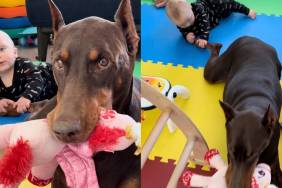Question:
How do I get my dog to listen to my children?
Answer:
It usually boils down to inconsistency. Children tend to be inconsistent in their behaviors while dogs thrive on predictability. Dogs are simply more apt to listen to people who establish clear rules and set explicit boundaries.
Dogs live in a black and white world and don’t understand sudden changes. Children’s behavior, however, changes sharply and often; they may be smiling and giggling one minute and crying and storming around the room the next. Or, they might encourage chase games before lunch but scream for help when the dog approaches after dinner. Understandably, this behavior is very confusing–your dog has no idea when it’s “chase time” and when it isn’t.
When their owners’ behavior is unclear or inconsistent, dogs tend to make their own rules. And since children have a difficult enough time following rules parents set, expecting a child to consistently adhere to the guidelines of dog training might be expecting too much. (Of course, this depends on the age and maturity of the child–or anyone in the household, for that matter.)
To be fair to both, I always suggest that the adults in the family take on the leadership role. I can’t think of anything worse for your dog than having to report to five individuals (two adults and three children, for instance), all with different expectations. I recommend that the adults set the boundaries for the children and the dog–and then ensure that both children and dog are following the rules. Under no circumstance should a child ever be permitted to punish a dog.
That said, children can certainly be involved in the training, but when it comes to “commanding” the dog, an adult should always be present. That way, the parent can reinforce what the child is asking of the dog and avoid frustration for both. And ultimately, teaching tricks and games using reward-based training will have a lasting positive effect on both species.









